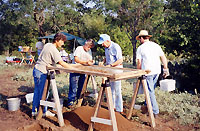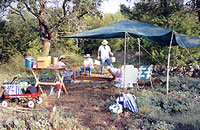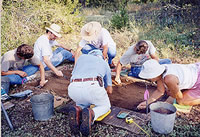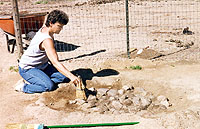Behind the Scenes: Triumph of an All-Volunteer Operation |
||||||||
|
By Susan Dial One story that remains to be told about the Graham-Applegate site is what has gone on behind the scenes—how an all-volunteer crew of archeological novices has been led week after week by a quiet young archeologist to uncover a 1000-year-old village. In some ways, their story is just as remarkable as that of the rancheria, for it has taken determination and an unusual blending of personalities to continue the project in the face of sparse funds, bad weather, and dwindling numbers in the crew. Of the three dedicated Llano Archeological Society (LUAS) members who have seen the project through from day one, each credits the others with a large measure of the success. Chuck Hixson: "The Perfect Teacher"The quiet but steady force behind the Graham-Applegate
project is Chuck Hixson, an archeologist trained in the southwest
but knowledgeable about the idiosyncrasies of central Texas prehistory.
While attaining his B.A. and M.A.degrees in anthropology at the
University of Texas at Austin, Hixson developed a keen interest
in southwestern pottery-making technology that developed into a
thesis project (his topic was a study of the paint on Mogollon Black-on-White
pottery). Today, he has transformed his technical knowledge into
an art. Using open firing pits and aboriginal techniques, Hixson
produces exquisitely thin-walled, bone-tempered vessels from clays
he has collected from throughout the local area. His
vessels provide a startlingly graphic
example of the artistic capabilities of the Late Prehistoric peoples
in Texas. He also reproduces prehistoric Southwestern pottery of
several different styles, including the fine Mimbres Black-on-White.
In LUAS, Hixson has served as president and as a general organizer, and he still leads many of the group's monthly field trips. Under his tutelage, LUAS members have recorded bedrock mortar holes in stony ledges, visited historic ranch sites dating to the 1870s, and investigated huge rock mounds thought by the landowner to be burial cairns. Hixson also serves as a steward for the Texas Historical Commission, giving periodic talks and assisting landowners in preserving and documenting cultural remains on their properties. Of course, the landowner Hixson most vividly recalls meeting for the first time was Charlotte Graham, who came into the Nightengale Center "carrying a handful of Scallorn arrow points." It was a critical connection that developed into a friendship and strong working relationship. And from it emerged the opportunity to tell the story of the folk who lived a thousand years ago, at what has become known as the Graham-Applegate Rancheria. Charlotte Graham: From Collector to ColleagueCharlotte Graham, on whose rocky acres the Graham-Applegate site was first discovered, serves the project in a far greater capacity than mere landowner. Both in her kitchen "lab," where she has single-handedly washed, labeled, and catalogued nearly 12,000 artifacts, and on the site, where she has developed a keen eye for subtle clues in the earth, the California native continues to play a critical role in site operations. A "recovered" collector, she has taken on a more steady, scientific approach in her work. Where at one time she and her sister, Janice Zimmermann, occasionally picked up and probed for arrow points and tools from the slopes and draws near her house, both now have learned the value of plotting artifact locations, excavating systematically, and preserving the context of all the evidence. Graham is adamant about safeguarding the site; in fact, she is convinced that she was meant to have the property for just that reason. While driving through the area with a realtor several years ago, she says she felt a particular twinge when she saw the property that was to become her home and, as it developed later, the excavation site. "For some reason, I knew I had to have it. We made a deal on the spot. I didn't know why, then, but I think now it was because I'm supposed to be the guardian of the site and to help tell the story." A former coach for the Pan American Games, Graham brings the passion and endurance of an athlete to her work at the site. But, she notes somewhat ruefully, "I had no idea what I was getting into when we first started." Nonetheless, even after several bouts of bad health including a recent stint in the hospital, she is back on the job, determined to "get to the bottom" of the site and the many unanswered questions. Graham's experience with coaching among the Aborigines in Australia primed her with firsthand experiences with prehistoric lifeways. She recalls sitting in a hut—perhaps not unlike those being unearthed on her property—and watching the men come in from a hunt, carrying fresh kill. "They dropped the animal in front of the women, and then walked off. I mean, those women had to do everything!" Thinking about the people that lived here more than a 1000 years ago "gives me goose bumps," she says. "I dig down and I'm standing on the same surface they were. I don't even have to use my imagination to see it." Gene Schaffner: A Versatile LieutenantAlong with Graham, another critical leader at the site has been Gene Schaffner of Horseshoe Bay. A Missouri native and former nurse, Shaffner brings a questioning mind and meticulous care to her work, Hixson says. When she and her husband, Bob, moved to the Lake LBJ area from Illinois, they joined the Llano Uplift Archeological Society (LUAS). Gene Schaffner served as president from 1997-1999 and still leads tours for the public at the Nightengale Archeological Society in Kingsland. On a recent 101-degree afternoon there, Schaffner took group after group through the center and—with the same enthusiasm—headed for the outdoor interpretive trails in the blazing sun. "She brings a lot of energy to LUAS," Hixson says. In addition to excavating, the Schaffners have also bought equipment, tarps, and ladders for the project, items which can break the budget of a small operation. Gene Schaffner also brings her photographic skills to the site—many of the images used in this webpage are hers. Help WantedAt the Nightengale Center, the camaraderie among the three is evident— there is much good-natured teasing. Charlotte Graham points out that the group of excavators used to be much larger "before Chuck made us dig trenches through the midden with a trowel!" (Many archeologists will use shovels or larger tools to excavate through the dense layers of rock in a typical burned rock midden.) The trench they dug was "thigh-high," Graham claims. "And then we did all the weighing of the rocks and sorting them all by size. That's when we lost a lot of our volunteers." But, as the story is now known, Hixson and his crew moved on from the midden to uncover—with painstaking care—the remains of perhaps the largest "rancheria" yet documented in central Texas, a rare place indeed. The success of the small crew is still being told today in their detailed documentation of the ancient house remains and work areas, now shown in the maps and photos on this web page, and in the carefully catalogued artifacts in the lab. Many archeologists and professors who have visited the site have commented on the professional quality of the work being done by the all-volunteer group. And as they knuckle down to uncover what may be yet a SIXTH house at the rancheria, they are not too proud to ask for help. For information on volunteer opportunities at the site, see How To Get Involved. 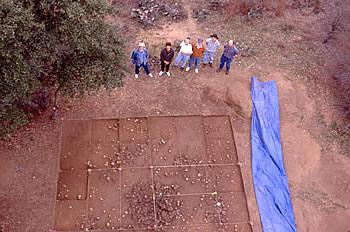
LUAS volunteers in front of House 1. From left,
Frank Sloan, Charlotte Graham, Gene Schaffner, Bob Gillespie, Project Director Chuck Hixson,and LCRA archeologist Dan Prikryl. Photo
by Andy Malof.
|
||||||||
|
||||||||
